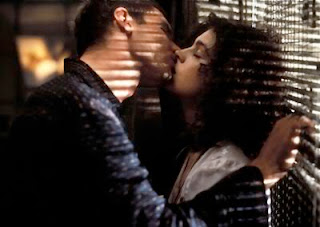The first thing to note is that I'm deliberately avoiding iconography -- so no Rubik's Cubes, New Romantic pop posters or asymmetric hairstyles. Instead I'm trying to suggest the period by use of colour, decoration and lighting; to provide a context for other items.
I'll start by looking at others who have tried to conjure that period visually in pastiche. (This gives a quick route to identifying the common signifiers, and saves re-inventing the wheel).
First up is the 2008 TV series Ashes to Ashes, in which detective Alexandra Drake was transported back through time into a stylised world of policing based on shows like The Gentle Touch, The Professionals and Dempsey & Makepeace.
 |
| See the programme intro here. |
 |
| Clip here. |
Talking of VHS (and on a general graphic design theme) next on my list is Justice's DVNO music video (2007), produced by the Machine Molle animation & VFX company. This video takes song lyrics turned into the kind of animated logos associated with companies like HBO, CBS Fox and Cannon Films during the 1980s.
Analysis
To achieve a 1980s look, a number of factors need to be included:
| Signifier: | Black |
|---|---|
| Why? | In the 1980s, black was the new brown. Film & video from this period is generally better preserved than 1970s stock, so the blacks are also a lot darker. There is heavy use of darkness and night-time as background (as opposed to the sunny look of the 70s). |
There were quite a few movies & TV shows in the 1970s with night-time scenes, but this seemed to become the prevalent look in the early 1980s.
 |
| Night-time scenes became more common in the 1980s, as demonstrated in this still from Joe Jackson's Steppin' Out music video |
| Signifier: | 80-85: Undersaturated colours (especially reds & blues); gold; black & white in contrast; 85-90: Pastel shades, overlit. |
|---|---|
| Why? | The 1980s palette is much wider than the previous decade; although primary colours are evident they are not vivid. This may be due to degradation of video tape (on which many programmes were shot, to save money). |
Here's a couple of examples of this in action:
 |
| Gary Numan, performing his Telekon album live. Note the muted red in contrast to the black. |
 |
| Larry Blackmon from the band Cameo in 1986, with trademark red codpiece. Note the pastel shades (behind) starting to come in. |
| Signifier: | Stripes! Stripes! Stripes! |
|---|---|
| Why? | In clothing, coloured stripes were fashionable, usually in contrast to black or white. |
The image below shows a number of elements in combination: red-and-black striped leotard (note the muted red); and black leg-warmers and footless tights.
This also extended to lighting: with the emphasis on darkness, scenes are often lit by light coming through blinds or bars.
 |
| The "lit through blinds" technique just screams '80s in this scene from Blade Runner. |
| Signifier: | Glow |
|---|---|
| Why? | Although airbrushed artwork had been around during the 1970s, the effect started to move into video work in the following decade. Cartoons like He-Man and the Masters of the Universe featured glowing magic |
Cartoons like He-Man and the Masters of the Universe featured incandescent elements as a matter of course, and most logos were not complete without an edge glow.
Next time we'll be looking at the difficult-to-pin-down 1990s.





